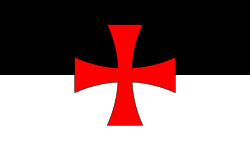
Back Tempelridders Afrikaans Orden d'o Temple AN Cnihtas þæm Temple ANG فرسان الهيكل Arabic فرسان المعبد ARZ Caballeros templarios AST Tampliyerlər Azerbaijani Tamplėirē BAT-SMG Тампліеры Byelorussian Тампліеры BE-X-OLD
| |
|---|---|
 Flag used by the Templars in battle | |
| Active | c. 1119 – c. 22 March 1312 |
| Allegiance | |
| Type | Roman Catholic military order |
| Role | Protection of the Christian pilgrims in Jerusalem (region) Shock troops |
| Size | 15,000–20,000 members at peak, 10% of whom were knights[1][2] |
| Headquarters | Temple Mount, Jerusalem, Kingdom of Jerusalem |
| Nickname(s) |
|
| Patron | Saint Bernard of Clairvaux |
| Motto(s) |
|
| Attire | White mantle with a red cross pattée |
| Mascot(s) | Two knights riding a single horse |
| Engagements | The Crusades |
| Commanders | |
| First Grand Master | Hugues de Payens |
| Last Grand Master | Jacques de Molay |
| Part of a series on the |
| Knights Templar |
|---|
 |
|
Poor Fellow-Soldiers of Christ and of the Temple of Solomon |
| Overview |
| Councils |
| Papal bulls |
|
| Locations |
| Successors |
| Cultural references |
| See also |
|
|
The Poor Fellow-Soldiers of Christ and of the Temple of Solomon, mainly known as the Knights Templar, was a French military order of the Catholic faith, and one of the wealthiest and most popular military orders in Western Christianity. They were founded c. 1119 to defend pilgrims on their way to Jerusalem, with their headquarters located there on the Temple Mount, and existed for nearly two centuries during the Middle Ages.
Officially endorsed by the Roman Catholic Church by such decrees as the papal bull Omne datum optimum of Pope Innocent II, the Templars became a favoured charity throughout Christendom and grew rapidly in membership and power. The Templar knights, in their distinctive white mantles with a red cross, were among the most skilled fighting units of the Crusades. They were prominent in Christian finance; non-combatant members of the order, who made up as much as 90% of their members,[1][2] managed a large economic infrastructure throughout Christendom.[3] They developed innovative financial techniques that were an early form of banking,[4][5] building a network of nearly 1,000 commanderies and fortifications across Europe and the Holy Land.[6]
The Templars were closely tied to the Crusades. As they became unable to secure their holdings in the Holy Land, support for the order faded.[7] Rumours about the Templars' secret initiation ceremony created distrust, and King Philip IV of France, deeply in debt to the order, turned this distrust to his own advantage. In 1307, he pressured Pope Clement V to have many of the order's members in France arrested, tortured into giving false confessions, and then burned at the stake.[8] Under further pressure, Pope Clement V disbanded the order in 1312.[9] The abrupt disappearance of a major medieval European institution gave rise to speculation and legends, which have currently kept the "Templar" name alive.
- ^ a b Burman 1990, p. 45.
- ^ a b Barber 1992, pp. 314–26
By Molay's time the Grand Master was presiding over at least 970 houses, including commanderies and castles in the east and west, serviced by a membership which is unlikely to have been less than 7,000, excluding employees and dependents, who must have been seven or eight times that number.
- ^ Selwood, Dominic (2002). Knights of the Cloister. Templars and Hospitallers in Central-Southern Occitania 1100–1300. Woodbridge: The Boydell Press. ISBN 978-0-85115-828-0.
- ^ Martin 2005, p. 47.
- ^ Nicholson 2001, p. 4.
- ^ Barber 1994.
- ^ Miller, Duane (2017). 'Knights Templar' in War and Religion, Vol. 2. Santa Barbara, California: ABC–CLIO. pp. 462–64. Retrieved 28 May 2017.
- ^ Barber 1993.
- ^ Barber, Malcolm (1995). The new knighthood : a history of the Order of the Temple (Canto ed.). Cambridge, UK: Cambridge University Press. pp. xxi–xxii. ISBN 978-0-521-55872-3.